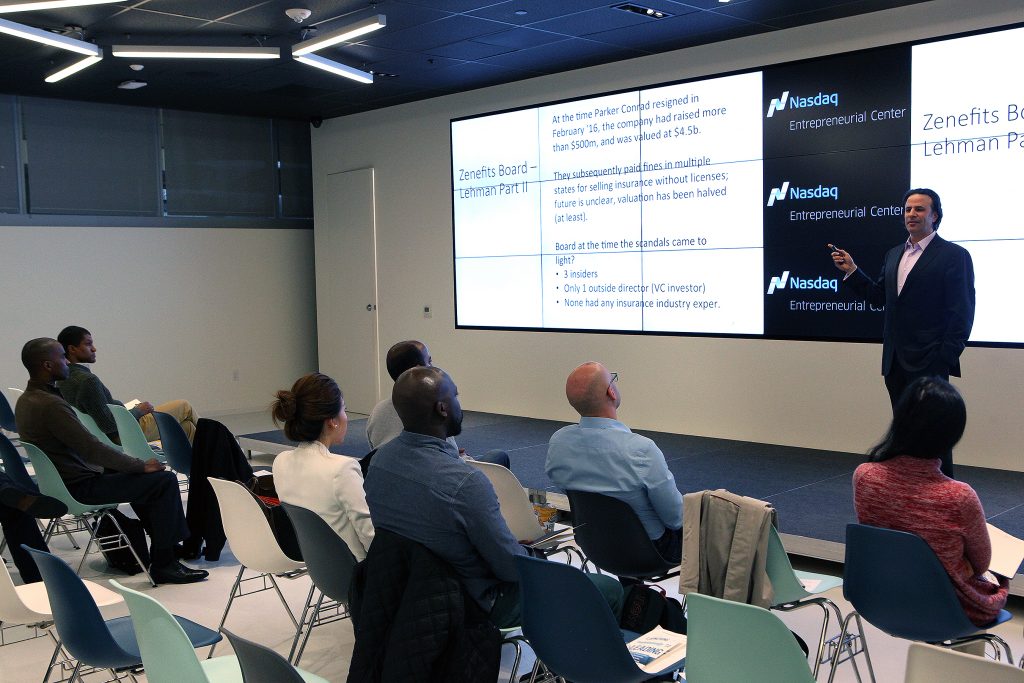Nasdaq Corporate Solutions Senior Analyst* Daniel Romito will be the first to tell you why data are among the largest and most strategic assets a company, regardless of size, can have. Clients of Nasdaq’s Strategic Capital Intelligence, which Romito leads, span North America, Europe, and Asia, and include companies with market capitalizations between $50 million and $185 billion. Romito is a recipient of Nasdaq’s CEO Platinum Award for his work modeling and influencing internal capital structure strategies. He received a BA from the University of Chicago and an MBA in finance from DePaul University, is a Level 3 chartered financial analyst candidate, and is an adjunct professor at Carthage College. In 2014, Romito created a quantitative analysis model that gauges the vulnerability of a corporate client to shareholder activists. What attracts activists to micro- and small-cap companies? And how can the directors of these companies use data to anticipate and respond to an activist? Romito provides some answers in this recent interview.
____________________________________________
What challenges are unique to micro- and small-cap issuers?
Relative to their larger counterparts, the competitive landscape for micro- and small-cap companies presents a unique set of challenges. These companies typically operate in a faster-paced environment that has a much smaller margin for error. This forces the board and management of these companies to constantly navigate with diminished resources and increased exposure to volatility. The micro- and small-cap investor must also address elevated risk and unpredictability, which compound management’s efforts in identifying longer-term investors. These impediments can distort tactical analysis and negatively impact strategic planning.
The structural composition of micro- and small-cap management teams also tends to create a noticeable disadvantage. While mid- and large-cap companies often place managers in more specialized roles that stress minute focus, micro- and small-cap managers are known to wear multiple hats, forcing them to pick and choose individual fires to extinguish rather than smothering the entire blaze.
Micro- and small-cap teams also manage unique buy-side dynamics. Micro- and small-cap fund managers must constantly address higher degrees of liquidity, volatility, and entry-price risk. The space is also inundated with high-frequency traders, an array of arbitrage strategies, and portfolio managers that incorporate much higher turnover. As a result, micro- and small-cap companies routinely struggle with investor relations.
How can market data analysis benefit micro- and small-caps?
Navigating capital markets challenges can improve when boards have access to high- quality data. Quality should be defined using three primary characteristics: objectivity, breadth, and the degree to which it is actionable. Relative to mid- and large-cap constituents, micro- and small-cap companies generally suffer from a lack of data that is objective, vast, and measurable. The data shortfall disadvantages smaller public companies in terms of managing their shareholder bases and pinpointing new pools of interested capital.
Nasdaq Corporate Solutions’ suite of tools was specifically designed to impartially complement management and board efforts by offering continuous intelligence that is unprejudiced and extremely actionable. Because we work with a wide variety of micro- and small-cap companies, we also possess a thorough understanding of best practices. This robust approach marries the best attributes of both the quantitative and empirical worlds by separating capital markets management into three distinct buckets: strategic, tactical, and measurable. The objective is to provide the data and perspective required to adequately execute strategy, adapt tactically to the ever-changing dynamics of the market, and measure the efficiency of a shareholder outreach plan.
What defines high-quality shareholder engagement?
Measuring the efficiency of a shareholder engagement plan must ultimately address how the initial strategy allocated assets among its participants. In this context, management’s time should be allocated wisely; offering an additional meeting to an investor can become counterproductive.
The trick is determining how to objectively and efficiently allocate time among different investors and how to display that efficiency to the board. Likewise, the board must also have access to data and appropriate benchmarks in order to fairly judge and effectively evaluate management’s strategy. Assessing risk within the shareholder base, pinpointing new capital, and prioritizing investors in an efficient manner demand data. Best practices reveal three distinct perspectives of time allocation: understanding ownership trends among current shareholders; establishing the behavioral tendencies of the overall micro- and small-cap investment community; and correctly prioritizing different pools of capital.
Each analysis should be executed utilizing detailed benchmarking. However, the quality of data underlying a respective benchmark can drastically skew performance, interpretation, and measurement—and usually misleads the team. Adapting incorrectly to a market catalyst is a very common theme we observe within this space. Unfortunately, this dynamic has a tendency to augment the principal-agent dilemma as well. For instance, poor benchmarking adversely affects management during the planning and execution phase while also impairing the board during the evaluation period. Utilizing smaller sample sets that fail to depict the market from a holistic and objective angle can place both the board and management at a substantial disadvantage.
How prevalent is activism at micro– and small-cap companies?
Quantifying all activist activity poses a challenge since not all discussions are publicly disclosed. Based on our client base, we have observed significant activist engagements among micro- and small-cap companies. This is typically spurred by the larger number of company targets. For that reason, it is critical to marry quantitative data with empirical and anecdotal evidence.
What has Nasdaq data revealed about activist investor behaviors?
Nasdaq’s Advisory Services team has access to unique data that allows us to analyze two critical components to an activist defense: reverse engineer the activist screening process to identify the fundamental metrics and profiles that make clients susceptible to shareholder activism; and map profiles of individual activist investors to proactively identify those investors most likely to engage in a client’s stock.
Our analyses on activism show us these investors are creatures of habit whose strategic execution rarely deviates. Moreover, activist investors are selective stock pickers motivated to uncover deep value opportunities. The pursuit of deep value primarily centers on identifying companies that display specific financial levers that provide an expansion of shareholder wealth. The opportunities that extend from these financial levers typically derive from capital deployment inefficiencies, sum-of-the-parts analysis, and controversial aspects of corporate governance.
Much like the rest of the market, activism is a distinct investment style that has evolved over time. A critical evolution that management and boards must accept is that activism is less taboo and continues to become more commonly accepted. Because many activists are focused on the long term, their alternative thesis and strategy are typically endorsed by a variety of top shareholders. As a result, activist investors are typically representing a larger contingent of their target’s top shareholders. Furthermore, we feel there are roughly 200 investors that incorporate some degree of activist tendencies within their portfolio. Accordingly, a broad continuum of behavioral tendencies exists within the activist community. It is, therefore, critical to understand the particular preferences and idiosyncrasies of individual activist investors. This ensures that management and the board possess the ability to effectively plan for an engagement and provide perspective on alternative strategies that larger shareholders may be more partial to.
Proactive scenario analyses based on behavioral tendencies of activist investors can provide an objective indication of potential vulnerabilities and alternative means to uncover untapped shareholder wealth. By retracing the behavioral tendencies of investors, boards and management can uncover potential vulnerabilities, identify investors that have displayed a distinct appetite for the particular profile, and pinpoint how a specific activist investor typically engages a company.
*Editor’s note: Subsequent to this piece’s publication, Mr. Romito is now the Global Head of Investor Analytics at Nasdaq.
This article was originally posted in Directorship Magazine, March/April 2017.
________________
Save



